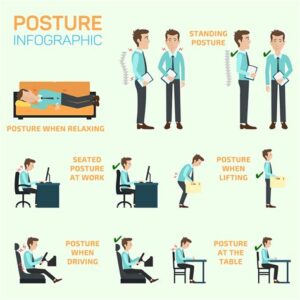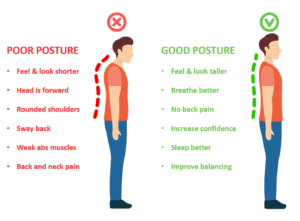Back to: Physical and Health Education JSS 2
Welcome to class!
In today’s class, we shall be talking about the Meaning and kinds of posture. Please enjoy the class!
Meaning and Kinds of Posture
What is Posture?

Posture, more than just how you stand, is the symphony of your body’s alignment. It’s the delicate interplay of muscles, bones, and joints working together to hold you upright, balanced, and ready to move with grace and ease. But good posture isn’t just about aesthetics; it’s the foundation for optimal health and a key player in preventing pain, fatigue, and even injuries.
So, what exactly is “good” posture?

Imagine a plumb line running down your body, from the crown of your head to the soles of your feet. Good posture aligns your body close to this imaginary line, with each segment stacked appropriately:
- Head: Chin slightly tucked, ears in line with shoulders, eyes level.
- Shoulders: Relaxed and down, not hunched forward.
- Spine: Gently curved in the neck and lower back, with a neutral arch in the middle.
- Hips: Level and balanced, neither tilted forward nor backward.
- Knees: Slightly bent, not locked.
- Feet: Shoulder-width apart, pointing straight ahead.
Think of this ideal alignment as a well-built bridge. When the weight is distributed evenly, the bridge stands strong and supports heavy loads. Similarly, good posture distributes your body weight efficiently, minimizing strain on muscles and joints.
But posture isn’t static! Just like a bridge adapts to different loads and changes in traffic, our posture constantly adjusts as we move, sit, and lie down. This leads us to the two main types of posture:
- Dynamic Posture: This is the way we hold ourselves while moving, like walking, running, or reaching for something. Maintaining good dynamic posture involves engaging the right muscle groups for each movement, ensuring coordinated and efficient action.
- Static Posture: This is the way we hold ourselves when stationary, like sitting at a desk, standing in line, or sleeping. Maintaining good static posture involves finding a balanced and comfortable alignment that minimizes muscle tension and fatigue over time.
But what happens when our posture goes astray?
Poor posture, where our body deviates significantly from the ideal alignment, can lead to a cascade of problems:
Muscle pain and aches: When muscles are constantly strained to support improper alignment, they become overworked and fatigued, leading to pain and tension.
Joint problems: Poor posture can put undue stress on joints, increasing the risk of arthritis and other joint issues.
Reduced flexibility and range of motion: Imbalanced muscles and shortened tissues can limit our ability to move freely and comfortably.
Fatigue and low energy: Maintaining poor posture drains energy, making us feel tired and sluggish.
Decreased confidence and self-esteem: Slouching and hunching can affect how we view ourselves and how others perceive us.
Fortunately, good posture is a skill that can be learned and improved! Here are some tips to get you started:
- Awareness is key: Pay attention to your posture throughout the day. Notice how you’re sitting, standing, and moving.
- Stretch and strengthen: Regular stretching and targeted exercises can help improve flexibility and strengthen muscles needed for good posture.
- Ergonomics matter: Set up your workspace and environment to support good posture, whether it’s adjusting your chair height, using a standing desk, or choosing the right backpack.
- Mindful movement: Incorporate conscious movement practices like yoga or Pilates into your routine to enhance body awareness and improve posture control.
- Be patient and consistent: Remember, good posture takes time and effort. Be patient with yourself and make small, gradual changes that become sustainable habits.
By mastering the art of alignment, you unlock a world of benefits for your body and mind. Good posture boosts your confidence, prevents pain, and helps you move with grace and ease. So, stand tall, hold your head high, and embrace the power of good posture!
Question Time:
Section A:
- Which of the following is NOT a benefit of good posture?
- a) Reduced muscle pain and aches
- b) Improved flexibility and range of motion
- c) Increased risk of arthritis
- d) Enhanced confidence and self-esteem
- The main difference between dynamic and static posture is:
- a) Dynamic posture is always correct, while static posture can be incorrect.
- b) Dynamic posture involves movement, while static posture does not.
- c) Dynamic posture is only used for standing, while static posture is only used for sitting.
- d) Dynamic posture requires more muscle engagement than static posture.
- Poor posture can contribute to all of the following EXCEPT:
- a) Fatigue and low energy
- b) Difficulty breathing
- c) Digestive problems
- d) Headaches
- Which of the following is NOT a tip for improving posture?
- a) Stretch and strengthen your muscles regularly.
- b) Sit up straight at your desk with your feet flat on the floor.
- c) Hold your phone in front of you instead of looking down at it.
- d) Carry heavy backpacks on one shoulder instead of both.
- What is the imaginary line that represents ideal posture from head to toe?
- a) The spinal cord
- b) The plumb line
- c) The midline
- d) The balance line
Section B:
- Explain the difference between good and bad posture, using specific examples of body alignment for each. (10 marks)
- Describe two ways in which poor posture can negatively impact your health and well-being. (10 marks)
- Discuss three strategies you can use to improve your dynamic posture during everyday activities like walking or running. (15 marks)
- Compare and contrast the challenges and benefits of maintaining good static posture while sitting at a desk for extended periods. (15 marks)
- Imagine you are creating a poster campaign to promote good posture in your school. Design a catchy slogan and outline three key messages you would want to convey. (10 marks)
